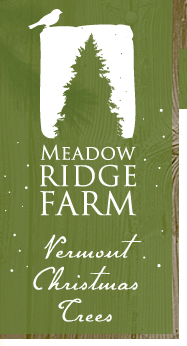It’s impossible to grow bananas in Vermont, and it’s darn tough work just getting tomato plants to come up in the spring. But our cold winters and moist summers provide the perfect climate for growing Christmas trees. So that’s what we do. Meadow Ridge Farm has more than 7,000 Christmas trees in the ground. Unfortunately, they didn’t get there on their own. Each spring, usually in late April, we plant another “rotation” of small trees. Just 12 inches tall, these trees already are 5 years old when we purchase them from a nursery. It takes another 7 to 10 years in our field before they’re ready to go in your home. Planting begins by using a gas-powered auger to drill a hole big enough to give the young roots room to grow. (We plant with the green side up—we’ve had better results that way.) The first year or two in the ground, the trees don’t grow much. During this time, our goal is mainly to keep the weeds from over-taking the tree, and to avoid mowing them over with the tractor. Soil fertility and pH are monitored and adjusted as needed. Each year, a new set of buds emerges and creates more growth over the entire tree. So once trees reach about waist high—and every year after that—they need to be “sheared.” This is what gives the trees the conical shape that everyone seems to prefer. Shearing is a summer-long activity. Beginning in mid-June, we go through the entire field and cut out any double-tops. (If the trees had more than one top, you’d need to decorate with more than one star or angel.) Shortly after, the sides of each tree are sheared using a long, very sharp shearing knife.
In late autumn, the chill in the air and a few frosts helps the needles “harden off” as the trees prepare for the cold, snowy months ahead. This also locks in the moisture and ensures the trees are fresh and fragrant come December. |
|















